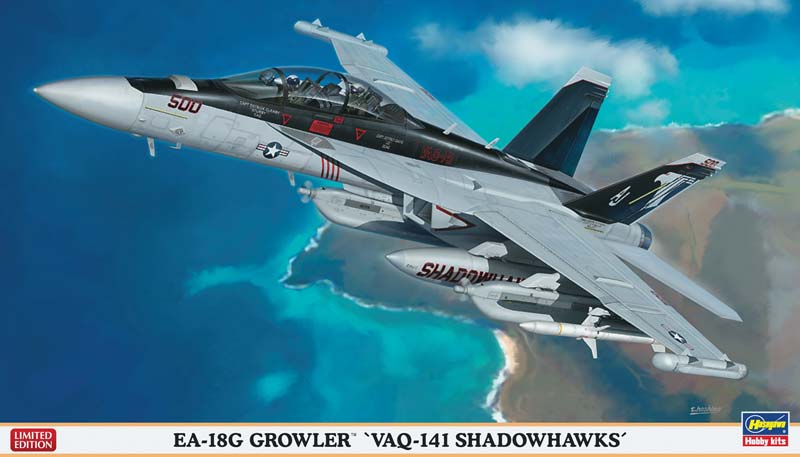EA-18G Growler,VAQ-141 Shadowhawks Limited Edition
The EA-18G Growler is the US Navy’s newest ECM aircraft, replacing the venerable Grumman EA-6B Prowler. Now in service with several squadrons, the EA-18G provides our military forces the latest hardware for electronic warfare. Boeing modified the basic two-seat FA-18F Super Hornet for the ECM mission by adding numerous antenna, sensors, and stores, and by removing offensive items such as the 20mm cannon. To produce a model of this machine, Hasegawa essentially did the same. They took their basic FA-18F Super Hornet kit and added sprues with all the relevant pieces to produce the G model.
Hasegawa’s release is in their standard gray plastic with delicate, recessed panel lines. While the surface detail is excellent, the cockpit detail is basic. That goes double for the ejection seats. The clear parts are crystal-clear, but the canopy has a seam line down the middle which will require attention. There are two marking options: VAQ-141 Shadowhawks and VAQ-138 Yellow Jackets COMVAQWINGPAC. Both are colorful CAG schemes over the standard TPS gray camouflage. Hasegawa didn’t skimp on the external stores,either, with the inclusion of three fuel tanks, two AMRAAM-120 missiles, two ALQ-99 high band jamming pods, one ALQ-99 low band jamming pod for the centerline, two ALQ-21 wingtip pods, and finally, two AGM-99E anti-radiation missiles.
IPMS/USA reviewers have dissected the FA-18F Super Hornet model three times, so I won’t go too deeply into the basic construction. I found their comments insightful and totally applicable to the EA-18G. The cockpit would benefit from some aftermarket ejection seats for more realism, particularly if you choose to open the canopy. I added belts and harnesses made of tape to the ejection seats to bring them to life. With the canopy closed, they looked convincing. Though not mentioned in the instructions, I added weight to the nose cone just in case it was a tail-sitter. To my mind, the intakes were a bit of a letdown. There was a large seam down the top of each intake trunk that is awkward to reach, and they ended at a blank wall in front of the main gear wells, less than half an inch from the opening. That said, you have to look very closely to see this construction. The aft fuselage where the upper and lower fuselage pieces meet the side panels required some sanding and filler. A word of caution about the fuselage: make sure you punch out all the holes for the ECM gear before you glue everything together. The same comment holds true for the wings. Double-check the instructions because there are a lot of openings to be drilled.
I assembled all the external stores and the ALQ-21 wingtip pods according to the instructions, but left them off until final assembly. Photos of these two particular aircraft did not show any weapons on them, so I only used the fuel tanks and ECM pods on my model. The instructions have you fill in the openings for the cannon on the upper part of the nose, since the G didn’t have a gun. They don’t tell you, however, to fill the vents on the lower nose (just forward of the nose gear well), but you should. I didn’t catch this until my model was completed, so they’re still there.
The last two pages of the instructions depict the painting and decaling guide for the two machines. I left off the vertical stabilizers and stuck a wooden coffee stir stick in one of the slots to help me hold the model while painting. Though both decal options were appealing, I chose the black and yellow scheme of VAQ-138. To make sure I had the right coverage for the black areas around the cockpit, I photocopied the yellow lightning bolts on the decal sheet for use as a template. These decals were among the best I have ever used. Colors were right on and in register. They were opaque and settled into the contours of the model without any setting solution. There are a ton of stencils; however, the lighter gray ones literally disappear on the lower fuselage and ECM pods.
Pictures of these CAG birds show no weathering except for some subtle stains on the lower fuselage aft of the main gear. I did add some grime to the landing gear, but I overdid it a bit. Use restraint here.
I really enjoyed building this EA-18G and am quite pleased with the result. Hasegawa did a superb job with this model and I would recommend it to anyone interested in modern aircraft. This build has motivated me to start the Hasegawa FA-18E and perhaps another EA-18G with the Navy’s three-color Centennial Scheme. My thanks go to Hasegawa, Hobbico, and IPMS/USA for providing the model for my review.






Comments
Add new comment
This site is protected by reCAPTCHA and the Google Privacy Policy and Terms of Service apply.
Similar Reviews